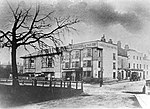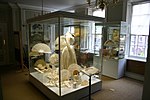20 Dartmouth Hill
Blackheath, LondonGrade II listed buildings in the Royal Borough of GreenwichGrade II listed houses in LondonHouses completed in the 18th centuryHouses in the Royal Borough of Greenwich ... and 2 more
London building and structure stubsUnited Kingdom listed building stubs

20 Dartmouth Hill is a Grade II listed building at 20 Dartmouth Hill, Blackheath, London, SE10.The house dates from the late 18th century. It was lived in by the meteorologist and aeronaut James Glaisher FRS (1809-1903).
Excerpt from the Wikipedia article 20 Dartmouth Hill (License: CC BY-SA 3.0, Authors, Images).20 Dartmouth Hill
Dartmouth Hill, London Deptford (London Borough of Lewisham)
Geographical coordinates (GPS) Address Nearby Places Show on map
Geographical coordinates (GPS)
| Latitude | Longitude |
|---|---|
| N 51.4717 ° | E -0.0078 ° |
Address
Dartmouth Hill 22
SE10 8AJ London, Deptford (London Borough of Lewisham)
England, United Kingdom
Open on Google Maps







